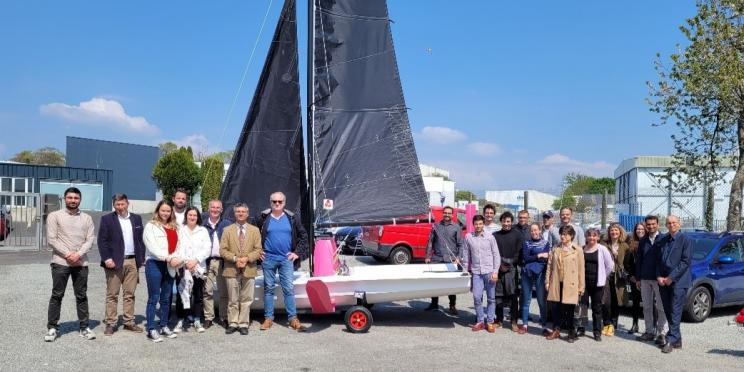FLOWER Project Closure Interview
14/04/2023

A question and answer session with Lise Dugor, FLOWER Project Manager.
Tell us about your project.
The FLOWER project aimed to develop locally produced flax fibre reinforcements for the composite industry at a lower cost. A composite material is composed of at least two materials, which combine to give properties superior to those of the individual constituents.
The outcomes of this project will enable us to achieve the aspirations of using sustainable, cost effective and environmentally friendly lightweight compositesas a viable alternative for automotive, advertising and sailing sectors.
The project partners cover the entire value-chain, from the cultivation of flax to the production of the final products: foiling boat (a sailing boat with wing-like foils mounted under the hull), biodegradable advertising display stands, car headliner (the material covering the ceiling of a vehicle. Four industrial partners (Kaïros, Teillage Vandecandelaère, EcoTechnilin and Howa-Tramico) prepared the semi-products (fabrics that will then be used with other materials to make the final prototypes) and final demonstrators. The academic partners, University of South Brittany, INRAe, University of Cambridge and University of Portsmouth, worked on the characterisation of the products by carrying out mechanical tests.
Normandy is the world leader in flax production and many companies, in both France and England, develop composite materials. Biocomposite development represents an additional opportunity to enhance local know-how and sustain local supply chains.
What have been the key outputs and results for FLOWER?
The project has opened up the field of possible applications of flax with the new semi-products. We explored the properties of the material and concrete applications. The foiling boat proves the feasibility of using natural fibres in the nautical sector. Partners are proud to have turned ideas into prototypes and to have become experts in flax bio-composites.
Moreover, there is now an increasing interest in England to use agricultural resources to meet net zero targets and in the future, England and North Brittany could be territories for the cultivation of flax due to global warming.
Finally, the JEC Group, the world’s leading organisation dedicated to promoting composite materials, awarded the project with the award for the point-of-sale advertising display stands and a finalist place for the car headliner (see below).

Can you tell us about the prototypes and how you plan (or already have started) to commercialise / roll out in industry?
The non-woven veil (EcoTechnilin), a light weight reinforcement, was used in two of the final products. In the car headliner (Howa Tramico), the veil is lighter than glass reinforcements, thus reducing the weight of cars and decreasing the quantity of CO2 released in the air. EcoTechnilin already has contacts with companies from the leisure and building sectors interested in future collaboration.
The point of sale advertising stand (Kairos), integrating the veil, is recyclable and compostable using an industrial process. It is a benefit given that these products typically have a short life cycle and are then thrown away.
Depestele created a woven fabric with flax for the foiling boat (Kairos). It was integrated in both the hulls and the foils, components that are critical in improving the speed, and pulling the hull out of the water. The boat won’t be commercialised but is used at a sailing school to raise awareness among the youth.
What lessons have you learned through this project?
We have been quite lucky with the FLOWER partners, as even with obstacles that we could not prevent, we succeeded in delivering what we had planned. However, there were of course some lessons learnt.
First, we learnt the importance of not giving up. Not everything will go according to plan, but it is necessary to keep working and find alternatives to achieve what was planned.
Secondly, regular meetings and reminders from the lead partner were important to keep up with the tasks and knowing at all time what the next ones were. It was not about controlling the partners but about making sure everything was going on well.
Finally, teamwork has been the most important key for the success of the project. The work partners have carried together has led to multiple benefits: many scientific papers, exchanges on specific knowledge that only one partner had.
What do you hope is the legacy of the project?
The main goal of the FLOWER project was to increase the use of biobased materials, and to promote their interest. We have proven through the three final demonstrators that products in the automotive, sailing and advertising sectors can be made with flax. In the future, hopefully more materials will be made using natural fibres rather than petrol-based ones.
Besides, the project rose awareness in people and strengthened the knowledge network. The partners have made great contacts during conferences and shows with other leading composite stakeholders. All the resources that we produced will remain available (see link below) and can be used for future studies, such as the deliverables and scientific papers.
We also hope to have grown interest in the younger generation, who will be the next decision makers and users of materials. The use of the foiling boat at the sailing summer school and the interventions in schools contributed to that.
The recently completed FLOWER project commenced in January 2018 and had a total budget of €5.3million (€3.6million ERDF).
More Information:
